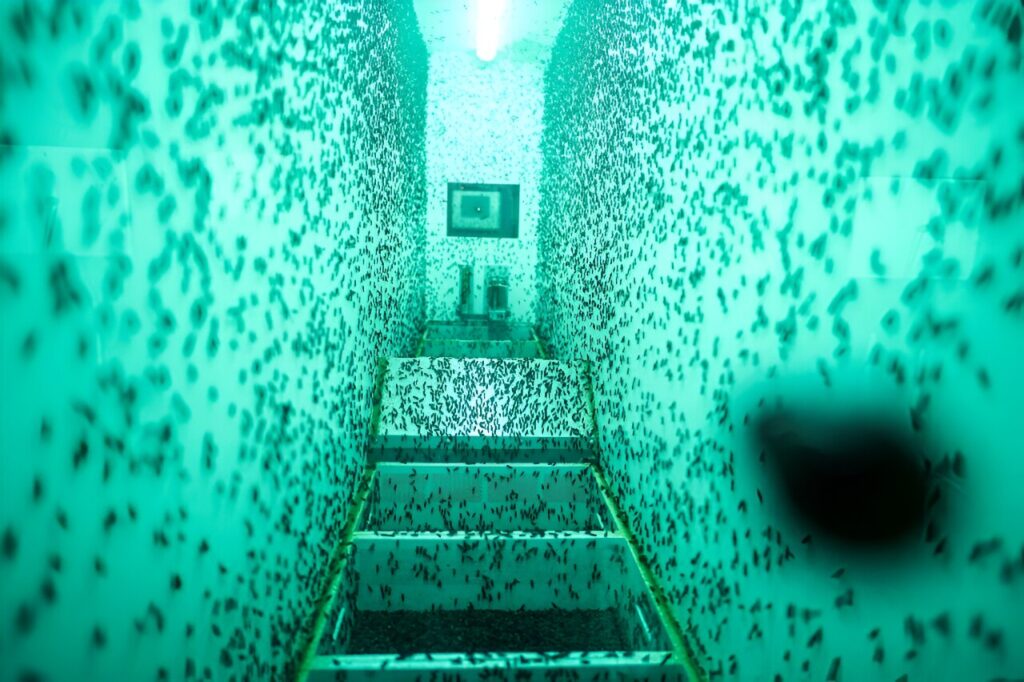Under turquoise fluorescent lights, millions of black flies buzzed inside some 500 plastic cages.
“It’s still a virgin industry, the volume in the market is still very limited,” admitted Lind Sam, whose factory has strived to use automation as much as possible.
But according to the International Platform of Insects for Food and Feed, the industry is growing and insect meal production could reach one million tonnes by 2030.
Roaring buzz
Under turquoise fluorescent lights, millions of black flies buzzed inside some 500 plastic cages, where they lay hundreds of thousands of eggs every day.
Inside the facility, it was impossible to escape the roar of insects who incessantly lay eggs throughout their 10-day lifespan.
“The female fly lays its eggs in this piece of cardboard,” Lind Sam explained as she pulled out a sheet with a honeycomb pattern at the bottom of one of the cages.
About 25 kilograms (55 pounds) of eggs are produced per day. A single gram corresponds to about 40,000 eggs.
Jane Lind Sam and her father, Carsten Lind Pedersen, swapped pigs for soldier flies.
From these eggs come some of tomorrow’s feeder flies, but also the future maggots which, once they have become pupae, will be transformed.
After 12 days, every 25 kilograms of eggs produces 100 tonnes of moist larvae.
Some 500 million maggots are kept in crates in tropical temperatures and fed using waste materials, such as orange peels collected from various local partners.
“They are fascinating animals. And I think it’s amazing that they can live on any organic matter,” Lind Sam said.
Niels Thomas Eriksen, a biologist at Aalborg University, told AFP that “insects can eat materials that other animals probably won’t so we can make better use” of agricultural byproducts and food waste.
Minimizing waste is one of Enorm’s key aims and the manufacturer stressed that the rearing of insects facilitates “the recycling of nutrients”.
It takes between 40 and 50 days to produce the finished product, which is mainly flour with a protein content of 55 percent.
After 12 days, every 25 kilograms of eggs produces 100 tonnes of moist larvae.
It takes between 40 and 50 days to produce the finished product, which is mainly flour with a protein content of 55 percent.
It is then distributed across Europe—although Enorm remains discreet about the identity of its customers—used for feed for pig, poultry, fish and pet farms.
The company noted that the larvae also hold “the potential for future integration into human nutrition”.
“It’s partially a cultural thing: ‘Who wants to eat them?’,” Eriksen said.
© 2024 AFP
Citation:
Danish insect farm sets sights on feeding Europe’s livestock (2024, July 17)
retrieved 8 October 2024
from https://phys.org/news/2024-07-danish-insect-farm-sights-europe.html
This document is subject to copyright. Apart from any fair dealing for the purpose of private study or research, no
part may be reproduced without the written permission. The content is provided for information purposes only.
Source link : https://phys.org/news/2024-07-danish-insect-farm-sights-europe.html
Author :
Publish date : 2024-07-17 07:00:00
Copyright for syndicated content belongs to the linked Source.
